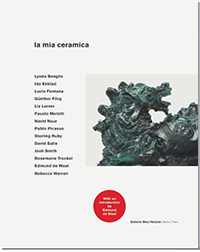Künstlerbücher / Special Editions
Almond, Darren / Blechen, Carl: Landschaften
Brown, Glenn: And Thus We Existed
Butzer, André: Exhibitions Galerie Max Hetzler 2003–2022
Chinese Painting from No Name to Abstraction: Collection Ralf Laier
Choi, Cody: Mr. Hard Mix Master. Noblesse Hybridige
Demester, Jérémy: Fire Walk With Me
Dienst, Rolf-Gunter: Frühe Bilder und Gouachen
Dupuy-Spencer, Celeste: Fire But the Clouds Never Hung So Low Before
Ecker, Bogomir: Man ist nie Alone
Elmgreen and Dragset: After Dark
Förg, Günther: Forty Drawings 1993
Förg, Günther: Werke in der Sammlung Friedrichs
Galerie Max Hetzler: Remember Everything
Galerie Max Hetzler: 1994–2003
Gréaud, Loris: Ladi Rogeurs Sir Loudrage Glorius Read
Grosse, Katharina: Spectrum without Traces
Hatoum, Mona (Kunstmuseum
St. Gallen)
Eric Hattan Works. Werke Œuvres 1979–2015
Hattan, Eric: Niemand ist mehr da
Herrera, Arturo: Boy and Dwarf
Hilliard, John: Accident and Design
Horn, Rebecca / Hayden Chisholm: Music for Rebecca Horn's installations
Huang Rui: Actual Space, Virtual Space
Kowski, Uwe: Gemälde und Aquarelle
Mikhailov, Boris: Temptation of Life
Mosebach, Martin / Rebecca Horn: Das Lamm
Neto, Ernesto: From Sebastian to Olivia
Oehlen, Albert: Spiegelbilder. Mirror Paintings 1982–1990
Oehlen, Albert: unverständliche braune Bilder
Oehlen, Pendleton, Pope.L, Sillman
Oehlen, Albert | Schnabel, Julian
Phillips, Richard: Early Works on Paper
Riley, Bridget: Gemälde und andere Arbeiten 1983–2010
Riley, Bridget: Die Streifenbilder 1961–2012
Riley, Bridget: Paintings 1984–2020
True Stories: A Show Related to an Era – The Eighties
Wang, Jiajia: Elegant, Circular, Timeless
Wool, Christopher: Westtexaspsychosculpture
Zhang Wei / Wang Luyan: Ein Gespräch mit Jia Wei
 |
|
|||
La mia ceramica Englisch / Französisch |
Für viele Maler und Bildhauer, Installations- und Konzeptkünstler bietet die Keramik eine besondere Ausdrucksform neben ihrer eigentlichen Disziplin. Oft liegt der besondere Reiz in der Unmittelbarkeit der Arbeit mit der Erde, im spontanen Zugriff auf die rohe Form. Das betont auch Lucio Fontana in seinem programmatischen Text „La mia ceramica“, dessen Titel der hier dokumentierten Ausstellung der Galerie Max Hetzler in Paris ihren Namen verleiht. Der Überblick beginnt in den späten 1940er-Jahren und spannt den Bogen von den damaligen Pionieren des Mediums – neben Fontana sind das Pablo Picasso und Fausto Melotti – bis in die aktuelle Gegenwart. Zu sehen sind rein abstrakte Arbeiten und frei ausgelegte Gefäßformen, spontaner Ausdruck und vielsinniges Konzept, mal bewusst Elemente der keramischen Tradition aufgreifend, mal ihre Grenzen sprengend. Im Wechselspiel der Arbeiten und durch Statements der Künstler über Geist und Praxis des Materials wird in diesem Buch der ganz persönliche Zugang deutlich, den die Keramik jedem von ihnen eröffnet hat.
La mia ceramica Clay becomes ceramic when it is fired. When clay is still in its raw state it can be broken down, mixed with water, reconstituted: objects can be made and remade indefinitely. Its plasticity is almost dangerous, it allows for revision and effacement. It has little resistance in comparison with wood or stone. Every touch is present but contingent. After firing, clay becomes other – it can be broken, chipped, made fragmentary – but it cannot return to its primal state. It is now unalterable, holding a record of the movements that made it: it is terramottata ma ferma, ‘earthquaked but motionless’, in Fontana’s vivid words. Clay and ceramic are polarised states of being, motion and stasis... Clay is inexhaustible stuff. It is cheap. It has little value in the hierarchy of materials: it is demotic, basic, primal. It is earth. As earth, it is universal but also particular as it comes out of territory, land, place. To work with it is to make something out of nothing. It is an act of Ur-creation: ‘God gave man a little bit of mud’, in Gauguin’s words. Clay records the passage of one moment of one person through the world. The use of clay to sketch, to mark in an abbreviated way the flux of feeling, is part of this map of the unexpected... Transformation takes place at different levels of seriousness, humour and complexity. But at every stage there are decisions as to whether to adopt the technics of ceramics. As Fontana said in the essay he wrote in 1939: ‘I abhor the mystics of technique… I am looking for something else.’
... |